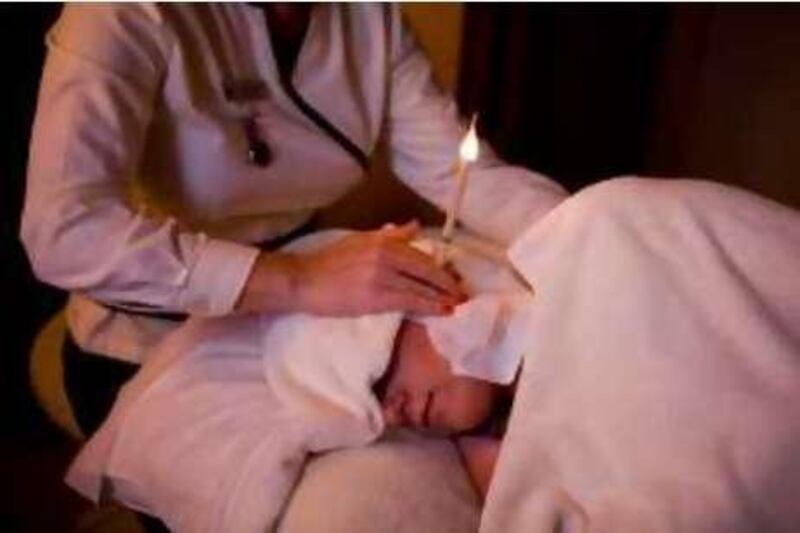Abu Dhabi // Doctors want a ban on ear candling, a procedure that is said to relieve sinus problems and headaches but can lead to burns or temporary hearing loss. The spa treatment, touted as an "ancient" therapy, involves inserting a special hollow candle, lit on one end, into the ear canal. Hot air supposedly draws out earwax with a vacuum effect.
But medical experts say not only are those claims implausible, the practice is dangerous. "You can burn your skin, you can burn your hair, the candle can perforate the eardrum," said Dr Ahmad Alamadi, the head of the ear, nose and throat department at Al Baraha Hospital in Dubai. One patient needed surgery days after having the treatment last year. Her hearing was reduced to 50 per cent, Dr Alamadi said. "I saw her ears completely blocked, but from the candle wax," he said. "The candle itself melted and went down the canal. It solidified and packed the whole ear. She was lucky it didn't burn the eardrums."
After administering general anaesthesia on the patient, Dr Alamadi took about two hours to scoop out "about three to four cubic centimetres of wax". "Trying to avoid damaging the skin of the canal was tricky work. It wasn't fun," he said. Dr Alamadi urged the Ministry of Health to follow the examples of the United States and Canada, which have banned the practice. Abu Dhabi's Department of Economic Development issues licences to spas and would be responsible for monitoring the activity, health officials said, but the department could not be reached for comment.
Khaleefa al Romaithi, who heads Abu Dhabi Municipality's public health administration, said: "We never hear about this kind of practice in Abu Dhabi." However, he said he would be interested in sending inspectors to find out more. In February, the US Food and Drug Administration (FDA) ordered ear-candle manufacturers to stop production. It found no evidence that the treatment was effective. A consumer advisory stated: "The FDA has received reports of burns, perforated eardrums and blockage of the ear canal which require outpatient surgery."
Canada banned the sale of ear candles in 2006. "It should be banned here, too," said Dr Navhin Saaoudi, an ear specialist at Zulekha Hospital in Dubai. "This is a kind of bluffing. I saw people after going through that, and they come to me to clean their ears because it takes nothing from the ear. It only takes people's money." Hiltonia Beach Club, at the Hilton hotel in Abu Dhabi, charges Dh240 for 45 minutes of ear candling, which may include a massage.
Barbara Toelen, 31, had the treatment there last week. "I hear lots of sizzling," said the Belgian hotel administrator, as the candle was lit in her first ear. That was normal, said Tracey Baldock, the spa co-ordinator. She has been performing the treatment for two years, and says she has regular clients who return several times a month. "We have a client who says, 'I have to come to you every couple months,' because she's a frequent flyer and gets lots of migraines," Ms Baldock said.
Apart from passing a one-day course on the procedure, Ms Baldock said no medical qualifications were needed to practise the therapy. "It's very safe and very easy," she said. "You've just got to be sensible when you're doing it to think about protecting the ear area, the face." Clients complete a consultation form listing allergies or potential complications beforehand. The candles, made from beeswax and woven cotton, burn for about 10 minutes each.
Ms Baldock said sceptics were usually convinced once she unfurled the used candle to reveal a heap of what was apparently earwax collected inside. Ms Toelen did not know what to make of what she saw. "Oh dear," she said, inspecting a chalky yellow substance inside the candle's filter. Most of the yellow was just dust from the ear candle itself, Ms Baldock explained. "But can you see that deeper orange colour? That darker orange lump here. That's the earwax," she said.
Detractors claim that anything left over in the candle is just candle wax. Ms Toelen's left ear yielded less orange, more yellow, suggesting less wax build-up, Ms Baldock said. Doctors say professional intervention - using a syringe or a light vacuum - is the safest way to unclog ears. Ear wax helps to prevent infection and does not usually need to be removed, said Riza Alathakandy, an audiologist in Dubai.
"It's a protective thing, actually," she said. "It's recommended not to remove earwax unless it's completely blocking the ear canal." @Email:mkwong@thenational.ae





